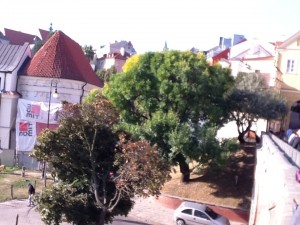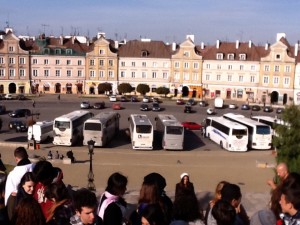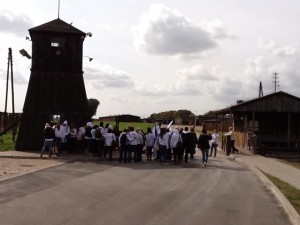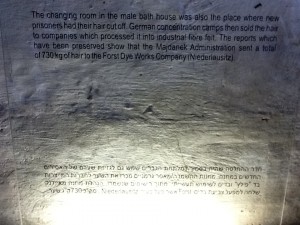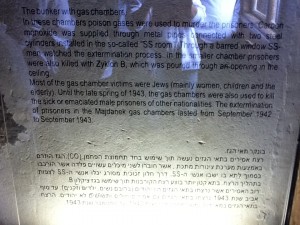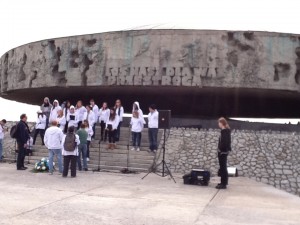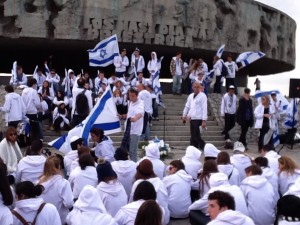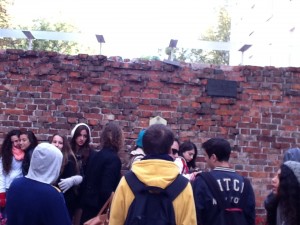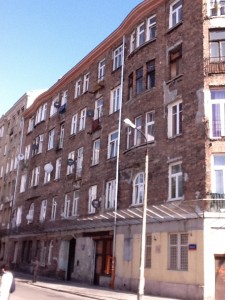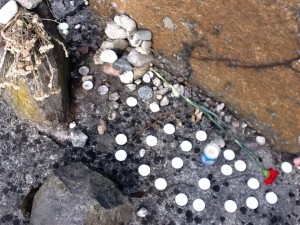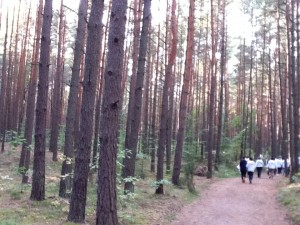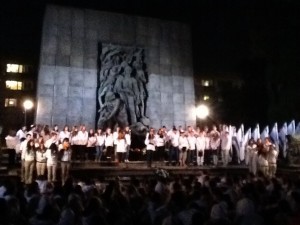Zameck
The castle of Lublin, place where the king lived. This Building is reconstructed, this is where Lita and Poland were united. King kazimish the great doesn’t leave anyone after him when he died, instead the princes from Hungary arrives here. Her name is Edviga and she is engaged to the prince of Germany, but they want her to marry the prince of Lita instead, but she refuses mainly since he is not Catholic, so he converts and Poland and Lita are united into the great Poland. She dies at 23 years old, but this is where the agreement about the unity was signed.
Jews lived here since the 14th century, around 44,000 of them and this is the center of the old city of Lublin. Jews then moved inside the city. There were lots of “Yeshivot” here, very rich Jewish life and very rich cultural life. During the war Odelio Globotznick is in control in Lublin, together with Hans Frank who controls Krakow, they both together run the Reindheart operation with the objective to clear the entire area from Jews.
The first thing Germans do here is to concentrate the Jews in the Lublin area. They tried first the “Nisco” plan, to put the Jews together in a small area and let them die naturally from hunger and deceases. This doesn’t work, so they decide to close the Ghetto and send the Jews to the death camps in Belzet or in Majdanek. The street light which is always on now days is left here by people of Lublin as a memorial to what used to be the Jewish community of Lublin and vanished during the war.
Inside the old quarter of Lublin
The inside of the city today used to be the Jewish Ghetto during the war. There was lots of Jewish community life here. We went through the “Grotzka Gate” leading to the quarter, nothing was left here except of that street light we passed. We follow a story of a Jewish family from the Ghetto, the Zytomirski family. Together with the Jews from here, they are all taken and sent to Belzen. Each year on April 14 lots of kids from Poland write letters to Henio Zytomirski, the child of that family who died. His father worked at the post office and lots of times he used to sign letter with “address unknown”, so the letters they write get signed by the post office with the signature “address unknown” and sent as a memorial. There is also a Facebook page which was opened in his memory. Interesting that these activities are done by a polish group, non Jewish theater group called “Brama Grotzski”, who were touched by the story of this child and his family.
What happened on the day after the war is over? Polish people take over the Jewish houses. Lublin is freed by Russians already on early 1944, Jews come back here and organize themselves again in community life. In January 1945 the first Zionist congress is held here, the topic is the question what are we going to do now? Stay in Poland or try and move to Israel which is under the British mandate? This question divided the Jews who survived, not all of them wanted to move to Palestine, lots decided to go back to their previous lives in Poland.
Another question is how do we get revenge now after the war is over? Jews are separated into groups, each group works on their own agenda and they are all waiting to the results of the war. They have also put the staff from Belzen camp on trial. There are only 2 Jews who survived Belzezc, when more than 300,000 Jews were killed at that camp.
This parking lot used to be where the houses of the Jewish quarter were:
Majdanek
Story of this camp begins already in Warshaw, we talk about Alina Birenbaum here, she was sent with her family to Majdanek near Lublin, we follow her book called “life in hope” החיים בתקווה
We start the walk into the camp, again with white delegation shirts, with flags and we also plan a ceremony inside. It’s very important and emmotional to enter the camps with flags and also in white, as if we want to say that we are coming here with pride, coming here strong and independent and officially represent the state of Israel, what a statement to make in the camps !
Majdanek stars as a war prisoners camp, becomes a concentration camp and then changes into a death camp. It tries first to teach people how to think inside the box like everyone else, re-educate them to think “the proper way” as the Natzi party wanted.
Israeli flags and the Majdanek monument behind:
The camp is only 2 kilometer away from the town of Lublin. This is true now but also was true when Jews were brought here to die. No one can say that they didn’t know what is happening, there is no way not to know when the camp is attached to your city.
First they bring here the polish elite for re-education and then the others. In the beginning of 1942 the camp became a death camp, October 1942 they started killing Jews here.
In 1942 there are already 6 working death camps all together.
When you walk down the path into the camp, the houses of Lublin on your right will slowly disappear as you go in. As you go down, your muscles try to stop you from entering, but there is nothing you can do to stop you from going inside and as you do, the city is still living it’s regular life as it used to do. The camp encloses you and you have no idea where you are and what is going to happen to you. This is the entrance to the camp now, and it is designed to show you what Jews felt as they walked into the camp and watched the city disappearing away from them.
In front of us is the camp itself, the road leading into the camp leads us into the dome of ashes, there is a mountain of ashes there, collected from all the burial fields around Majdanek. Most camps sent the ashes they collected to be used as fertilizers in Germany, this camp runs it’s agriculture alone and uses the ashes locally.
The road here looks as if it’s broken, it’s all part of the monument, there are cracks here, symbolizing the prisoners who lived here and can’t rebuild their life tho they were saved from the camp, but the terrible experience they had in this camp lives inside them and cracks their soul for ever. Up to the dome it’s all part of the monument built when the camp was opened for visitors.
Entrance to the camp today was the area where the soldiers and camp personel lived and where the SS buildings were. The building we see is front of us is the area where the women guards lived.
In 1944 the Russians came and cleared the camp, not leaving anything from the original camp. Instead, they planted trees as a memorial forest. They only left the gas area and two buildings together with some signs around the crematorium. The entire place was then covered with grass and was even used by local polish people as a picnic site. Then it was turned to be a memorial site, no picnics are allowed now, but you can still see people taking a short cut through the camp to get home behind the camp of today.
What is written on the monument is unclear, each one can see what he thinks and wants to see, you can look through and see the ashes mountain, with an inscription: “what happened to us is a warning for you” – this we have to remember when we visit Majdanek.
The white house on our right is the house of the doctors here, there were 2 doctors here, but instead of saving life they took life.
Karl Koch was the head of this camp. He was an accountant for the SS, stole money and was caught, instead of being put to jail he was sent to lead Majdanek since he was very close to Himler himself. His wife was Ilze Koch. Her hobby was to prepare lamps from skulls and skin of prisoners. Was she also a murderer or not? is she to be blamed as much as her husband who ran the camp?
This leads to a discussion of who is responsible for the holocaust, who is to be blamed, these who actually pulled the trigger, these who gave the orders or maybe also these who helped, these who took part or even these who knew and didn’t do anything to prevent this from happening? This is a very difficult question, there is no answer for that question, it’s one of the dilemmas of the Holocaust that we have to deal with.
The buildings on the right is where the gas rooms were, it can’t be seen now, we can just see the laundry room of this camp. Men and women are separated here and they enter the camp, men are taken to field number 2 and women are brought inside. The selection here is not like in Birkenau, Germans take these whom they think are not fit enough to an empty area between the fields, the rest stay here. These who were taken from the group never came back. Helina who wrote the book about this says her mom kept telling her that soon they will go into the bath, take a shower and then go out to work at the fields. As a little girl she was hoping for the line to move faster so she can get into the bath faster and then go to the block where she will have lots of food and be warm. She didn’t know that soon her mother will be taken into the bath and never return from there alive
Germans cut the hair of these who entered into the bath, they sold the hair to companies to process it into industrial fiber felt. Only hair from men was used for that. We have evidence of the Germans selling 730 kilo of hair to a factory to make mattresses for soldiers on submarines. Russians who came to liberate the camp found there hair waiting to be shipped to the factories. They also found there 800,000 shoes and a mountain of ashes.
Cutting your hair also takes away your human self respect. First the hair, then a number is tatood on your arm, your freedom is taken away from you, then your life to. We enter into these inner rooms now, this is what they thought are showers in a bathhouse, sometimes it was just real showers but most times wasn’t, in most cases it was the gas chambers. Here at the square of red roses as the prisoners called it because of also the blood spillt here, Helina’s mother was killed.
These are the real showers where they took the lucky ones who stayed alive, they were showered, disinfected and then sent to work. There is a very touching and shocking scene in the movie “Schiendler’s list” where the prisoners scream and are sure they are going to be gassed to death in the showers, till they realize these are regular showers and it’s actually water coming out.
But the rest, including Helina’s mother, were not that lucky, they were gassed to death here in this room. The blue color on the walls that we see until this day are remains of the gas, cyclon B, the gas comes in the shape of powder, in touch with air it becomes deadly gas that kills many people at once in a very short time, about 20 minutes. They even heated the bodies by making people take hot showers before they went into the gas chamber, this way the gas was more effective.
Some of the victims in Majdanek were killed using this gas. Most of them were killed using CO gas, which came from big dizel engines.
We look into the room where the gas was thrown to kill people, nothing much to see today, empty room, dark, closed, just with one picking hall where Germans could make sure that everyone inside are dead.
This is a song that says “years and nothing is forgotten”! Sang outside of the gas chambers in Majdanek
When a man cries inside his heart, only God can hear his cry, when the heart is quiet the soul inside shouts – words from another song we sang outside the room where Helina’s mother was killed.
We enter the restored part of the camp, camp 3, male compound:
The inside of block number 14, again 3 layers of people
In Majdanek you had to fight for everything, for food, for a place on the floor to sleep, for space, there was no place in Majdanek for the sick or weak people, survival of the fitted.
The crematorium:
November 3rd, 1943 Germans brought here more than 40,000 people and shot them on the fields behind us, on one day, 18,000 Jews were killed here from the camp, they ran them between the fences into the fields and at field 5 they made them take off their cloths, leave their valuables, go into the halls and shot them layer upon layer, while loud dance music was played through loudspeakers.
On November 5th they burned all the bodies here. The crematorium building is original. Inside the room stands a bed which was used to look for valuables inside people. They opened the bodies up to look for valuables that they might have swollowed. This is a sarcophagus which was used to store the remains of corpses burnt here, around July 1944:
The Germans used the heat produced from burning the bodies to heat the water for showers for the time prisoners would take their monthly shower. The German who operated the crematourium was hitting his shower water by burning bodies of gassed Jews. Rest of the ashes was added to the compost used to fertilize the soil for the nearby SS farm.
Mountain of ashes of victims:
We end this visit with a ceremony at the foot of the crematorium, near the mountain of ashes of victims murdered in Majdanek:
Click on this to listen to the song we heard at the foot of the mountain of ashes
End of day is the ceremony to remember the victims of Majdanek
Of course, we end this ceremony with singing the “Tikvah”
Tonight is Shabbat evening, the entire delegation has Shabbat dinner together, all in white shirts, traditional dinner with some songs and music, very hard after a day in Majdanek, but very powerful experience specially after such a day of death.
Shabbat Shalom !
Sabbath of peace – this is the traditional blessing we bless each other on Shabbat, it is much more meaningful in Poland, after a day in Majdanek, peach is what we all pray for.
We all had dinner together, starting with couple of songs to receive the Shabbat:
The song “Adon Olam”
The song “Yachad”



